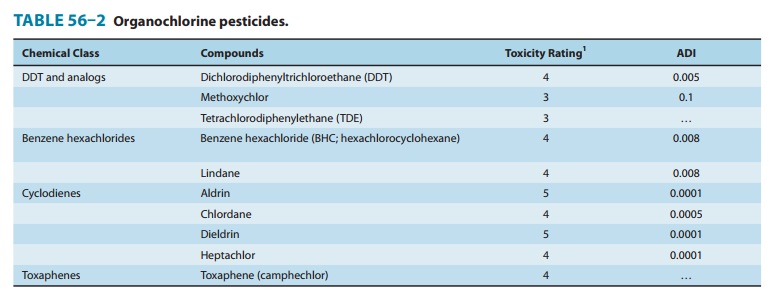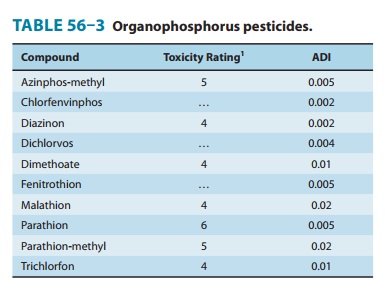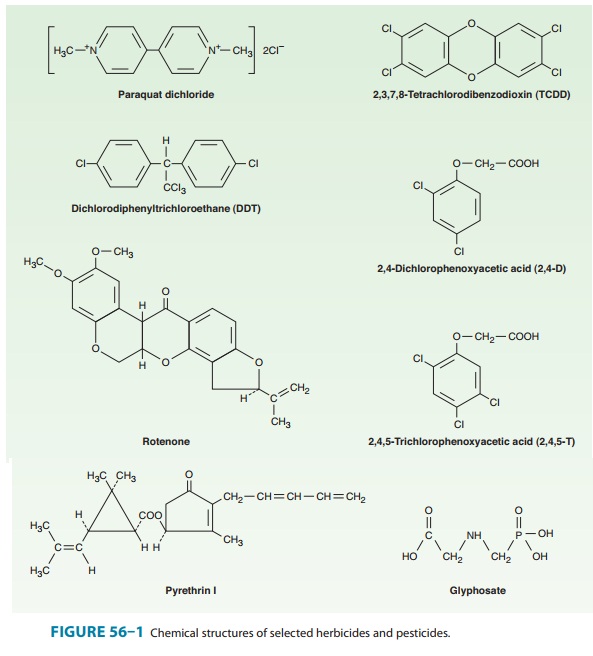Chapter: Basic & Clinical Pharmacology : Introduction to Toxicology: Occupational & Environmental
Pesticides - Specific Chemicals
PESTICIDES
Organochlorine Pesticides
These
agents are usually classified into four groups: DDT (chlo-rophenothane) and its
analogs, benzene hexachlorides, cyclo-dienes, and toxaphenes (Table 56–2). They
are aryl, carbocyclic, or heterocyclic compounds containing chlorine
substituents. The individual compounds differ widely in their
biotransforma-tion and capacity for storage in tissues; toxicity and storage
are not always correlated. They can be absorbed through the skin as well as by
inhalation or oral ingestion. There are, however, important quantitative differences
between the various deriva-tives; DDT in solution is poorly absorbed through
the skin, whereas dieldrin absorption from the skin is very efficient.
Organochlorine pesticides have largely been abandoned because they cause severe
environmental damage. DDT continues to have very restricted use for domestic
mosquito elimination in malaria-infested areas of Africa. This use is
controversial, but it is very effective and is likely to remain in place for
the foresee-able future. Organochlorine pesticide residues in humans, ani-mals,
and the environment present long-term problems that are not yet fully
understood.

A. Human Toxicology
The acute toxic properties of all the organochlorine pesticides in humans are qualitatively similar. These agents interfere with inactivation of the sodium channel in excitable membranes and cause rapid repetitive firing in most neurons.
Calcium ion trans-port is inhibited.
These events affect repolarization and enhance the excitability of neurons. The
major effect is central nervous system stimulation. With DDT, tremor may be the
first manifes-tation, possibly continuing to convulsions, whereas with the
other compounds convulsions often appear as the first sign of intoxication.
There is no specific treatment for the acute intoxi-cated state, and management
is symptomatic.
The
potential carcinogenic properties of organochlorine pesti-cides have been
extensively studied, and results indicate that chronic administration to
laboratory animals over long periods results in enhanced oncogenesis. Endocrine
pathway disruption is the postulated mechanism. Extrapolation of the animal
observa-tions to humans is controversial. However, several large epidemio-logic
studies found no significant association between the risk of breast cancer and
serum levels of DDE, the major metabolite of DDT. Similarly, the results of a
case-control study conducted to investigate the relation between DDE and DDT
breast adipose tissue levels and breast cancer risk did not support a positive
asso-ciation. In contrast, recent work supports an association between
prepubertal exposure to DDT and brain cancer. In addition, recent studies
suggest that the risk of testicular cancer is increased in persons with
elevated DDE levels. The risk of non-Hodgkin’s lymphoma (NHL) also seems to be
increased in persons with elevated oxychlordane residues. Therefore, increased
cancer risk in people exposed to the halogenated hydrocarbon pesticides is of
concern.
B. Environmental Toxicology
The
organochlorine pesticides are considered persistent chemicals. Degradation is
quite slow when compared with other pesticides, and bioaccumulation,
particularly in aquatic ecosystems, is well documented. Their mobility in soil
depends on the composition of the soil; the presence of organic matter favors
the adsorption of these chemicals onto the soil particles, whereas adsorption
is poor in sandy soils. Once adsorbed, they do not readily desorb. These
compounds induce significant abnormalities in the endocrine bal-ance of
sensitive animal and bird species, in addition to their adverse impact on
humans. Their use is appropriately banned in most areas.
Organophosphorus Pesticides
These agents, some of which are listed in Table 56–3, are used to combat a large variety of pests. They are useful pesticides when in direct contact with insects or when used as plant systemics, where the agent is translocated within the plant and exerts its effects on insects that feed on the plant. These agents are based on com-pounds such as soman, sarin, and tabun, which were developed for use as war gases. Some of the less toxic organophosphorus com-pounds are used in human and veterinary medicine as local or systemic antiparasitics. The compounds are absorbed by the skin as well as by the respiratory and gastroin-testinal tracts. Biotransformation is rapid, particularly when com-pared with the rates observed with the chlorinated hydrocarbon pesticides. Storm and collaborators reviewed current and suggested human inhalation occupational exposure limits for 30 organo-phosphate pesticides (see References).

A. Human Toxicology
In mammals as well as
insects, the major effect of these agents is inhibition of acetylcholinesterase
through phosphorylation of the esteratic site. The signs and symptoms that
characterize acute intoxication are due to inhibition of this enzyme and
accumula-tion of acetylcholine; some of the agents also possess direct
cholin-ergic activity. Altered neurologic and cognitive functions, as well as
psychological symptoms of variable duration, have been associated with exposure
to these pesticides. Furthermore, there is some indication of an association of
low arylesterase activ-ity with neurologic symptom complexes in Gulf War
veterans.
In addition to—and
independently of—inhibition of acetyl-cholinesterase, some of these agents are
capable of phosphorylat-ing another enzyme present in neural tissue, the
so-called neuropathy target esterase. This
results in progressive demyelina-tion of the longest nerves. Associated with
paralysis and axonal degeneration, this lesion is sometimes called
organophosphorus ester-induced delayed polyneuropathy (OPIDP). Delayed central
and autonomic neuropathy may occur in some poisoned patients. Hens are
particularly sensitive to these properties and have proved very useful for
studying the pathogenesis of the lesion and for identifying potentially
neurotoxic organophosphorus derivatives. In humans, neurotoxicity has been
observed with triorthocresylphosphate
(TOCP), a noninsecticidal organophosphorus com-pound. It is also thought to
occur with the pesticides dichlorvos, trichlorfon, leptophos, methamidophos,
mipafox, trichloronat, and others. The polyneuropathy usually begins with
burning and tingling sensations, particularly in the feet, with motor weakness
a few days later. Sensory and motor difficulties may extend to the legs and
hands. Gait is affected, and ataxia may be present. Central nervous system and
autonomic changes may develop even later. There is no specific treatment for
this form of delayed neurotoxic-ity. The long-term prognosis of neuropathy
target esterase inhibi-tion is highly variable. Reports of this type of
neuropathy (and other toxicities) in pesticide manufacturing workers and in
agri-cultural pesticide applicators have been published.
B. Environmental Toxicology
Organophosphorus
pesticides are not considered to be persistent pesticides. They are relatively
unstable and break down in the environment as a result of hydrolysis and
photolysis. As a class they are considered to have a small impact on the
environment in spite of their acute effects on organisms.
Carbamate Pesticides
These
compounds (Table 56–4) inhibit acetylcholinesterase by carbamoylation of the
esteratic site. Thus, they possess the toxic properties associated with
inhibition of this enzyme as described for the organophosphorus pesticides. The
clinical effects due to car-bamates are of shorter duration than those observed
with organo-phosphorus compounds. The range between the doses that cause minor
intoxication and those that result in lethality is larger with carbamates than
with the organophosphorus agents. Spontaneous reactivation of cholinesterase is
more rapid after inhibition by the carbamates. Although the clinical approach
to carbamate poison-ing is similar to that for organophosphates, the use of
pralidoxime is not recommended.

The
carbamates are considered to be nonpersistent pesticides.They exert only a
small impact on the environment.
Botanical Pesticides
Pesticides derived
from natural sources include nicotine,
rote-none, and pyrethrum. Nicotine
is obtained from the dried leavesof Nicotiana
tabacum and N rustica. It is
rapidly absorbed from mucosal surfaces; the free alkaloid, but not the salt, is
readily absorbed from the skin. Nicotine reacts with the acetylcholine receptor
of the postsynaptic membrane (sympathetic and para-sympathetic ganglia,
neuromuscular junction), resulting in depo-larization of the membrane. Toxic
doses cause stimulation rapidly followed by blockade of transmission. Treatment
is directed toward maintenance of vital signs and suppression of convulsions.
Rotenone (Figure 56–1)
is obtained from Derris elliptica, D mallaccensis, Lonchocarpus utilis, and L
urucu. The oral ingestionof rotenone produces gastrointestinal irritation.
Conjunctivitis, dermatitis, pharyngitis, and rhinitis can also occur. Treatment
is symptomatic.

Pyrethrum
consists of six known insecticidal esters: pyrethrin I (Figure 56–1), pyrethrin
II, cinerin I, cinerin II, jasmolin I, and jasmolin II. Synthetic pyrethroids
account for an increasing percent-age of worldwide pesticide usage. Pyrethrum
may be absorbed after inhalation or ingestion; absorption from the skin is not
significant. The esters are extensively biotransformed. Pyrethrum pesticides
are not highly toxic to mammals. When absorbed in sufficient quanti-ties, the
major site of toxic action is the central nervous system; excitation, convulsions,
and tetanic paralysis can occur. Voltage-gated sodium, calcium, and chloride
channels are considered tar-gets, as well as peripheral-type benzodiazepine
receptors. Treatment of exposure is usually directed at management of symptoms.
Anticonvulsants are not consistently effective. The chloride channel agonist,
ivermectin, is of use, as are pentobarbital and mephenesin. The pyrethroids are
highly irritating to the eyes, skin, and respira-tory tree. They may cause
irritant asthma and, potentially, reactive airways dysfunction syndrome (RADS)
and even anaphylaxis. The most common injuries reported in humans result from
their aller-genic and irritant effects on the airways and skin. Cutaneous
par-esthesias have been observed in workers spraying synthetic pyrethroids. The
use of persistent synthetic pyrethroids for aircraft disinfection to comply
with international rules regarding prevention of transfer of insect vectors has
resulted in respiratory and skin problems, as well as some neurologic
complaints in flight attendants and other aircraft workers. Severe occupational
exposures to syn-thetic pyrethroids in China resulted in marked effects on the
central nervous system, including convulsions.
Related Topics